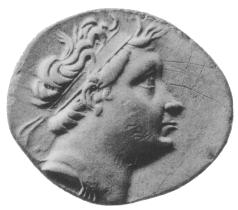Related Research Articles

Bithynia was an ancient region, kingdom and Roman province in the northwest of Asia Minor, adjoining the Sea of Marmara, the Bosporus, and the Black Sea. It bordered Mysia to the southwest, Paphlagonia to the northeast along the Pontic coast, and Phrygia to the southeast towards the interior of Asia Minor.

Nicomedes I, second king of Bithynia, was the eldest son of Zipoetes I, whom he succeeded on the throne in 278 BC.

Nicomedes II Epiphanes was the king of Bithynia from 149 to c. 127 BC. He was fourth in descent from Nicomedes I. Nicomedes II was the son and successor of Prusias II and Apame IV. His parents were related as they were maternal cousins.

Nicomedes IV Philopator was the king of Bithynia from c. 94 BC to 74 BC. He was the first son and successor of Nicomedes III of Bithynia.

The League of Corinth, also referred to as the Hellenic League, was a federation of Greek states created by Philip II in 338–337 BC. The League was created in order to unify Greek military forces under Macedonian leadership (hegemony) in their combined conquest of the Persian Achaemenid Empire.

Prusias I Cholus was a king of Bithynia, who reigned from c. 228 to 182 BC.

Prusias II Cynegus was the Greek king of Bithynia. He was the son and successor of Prusias I and Apama III.
Ziaelas, third king of Bithynia, was a son of Nicomedes I and Ditizele.
Zipoetes I, also Zipoites I or Ziboetes I, possibly Tiboetes I was a ruler of Bithynia.

Leonnorius was one of the leaders of the Celts in their invasion of Macedonia and the adjoining countries.
Etazeta was the second wife of Nicomedes I, king of Bithynia. After his death, she was a regent of Bithynia.
Nicomedes III Euergetes was the king of Bithynia, from c. 127 BC to c. 94 BC. He was the son and successor of Nicomedes II of Bithynia.
Zipoetes II, also Zipoites II or Ziboetes II, possibly Tiboetes II was a ruler of Bithynia from 279 BCE to 276 BCE; his name, which survives chiefly in Hellenized forms, has three syllables.
Socrates Chrestus was the second son of Nicomedes III of Bithynia. He usurped the Bithynian throne by deposing his elder brother or half brother, Nicomedes IV of Bithynia.
Astacus is an ancient city in Bithynia; it was also called Olbia. Its site is located near the modern Başiskele.

The Kingdom of Bithynia was a Hellenistic kingdom centred in the historical region of Bithynia, which seems to have been established in the fourth century BC. In the midst of the Wars of the Diadochi, Zipoites assumed the title of king (basileus) in 297 BC. His son and successor, Nicomedes I, founded Nicomedia, which soon rose to great prosperity. During his long reign, as well as those of his successors, Prusias I, Prusias II and Nicomedes II, the Kingdom of Bithynia prospered and had a considerable standing and influence among the minor monarchies of Anatolia. But the last king, Nicomedes IV, was unable to maintain himself in power against Mithridates VI of Pontus. After being restored to his throne by the Roman Senate, he bequeathed his kingdom through his will to the Roman republic in 74 BC and it became the province of Bithynia et Pontus in 63 BC.
Andronicus of Pergamum was an ambassador of Attalus II Philadelphus. He was sent to Rome in 156 BCE, to inform the Roman Senate that Prusias II of Bithynia had attacked the territories of Attalus.
Nymphis, son of Xenagoras, a native of Heraclea Pontica, lived in the middle of the third century BC, and was a person of distinction in his native land, as well as a historical writer of some note.

Bithynian coinage refers to coinage struck by the Kingdom of Bithynia that was situated on the coast of the Black Sea.

The Bosporan era, also called the Bithynian era, Pontic era or Bithyno-Pontic era, was a calendar era used from 149 BC at the latest until at least AD 497 in Asia Minor and the Black Sea region. It originated in the Bithynian Kingdom and was also used in the Pontic Kingdom and, for the longest time, in the Bosporan Kingdom. The calendar era begins with the assumption of the royal title by Zipoetes I of Bithynia in October 297 BC, which marks the start of its year one. The Bosporan year began at the autumnal equinox.
References
- 1 2 3 Williams 1990, p. 10.
- ↑ The Penny Cyclopaedia of the Society for the Diffusion of Useful Knowledge: Bassantin - Bloemaart, Volume 4 Society for the Diffusion of Useful Knowledge Knight, 1835 p. 470
- 1 2 3 4 5 6 7 8 Smith 2004, Chapters 1–21.
- 1 2 Olmstead 2022, p. 344.
- 1 2 3 4 Slavova, Mirena (2015). "The Thracian Diphthong /oi/ Revisited". Studia classica Serdicensia: 144–145. Retrieved 14 March 2023.
- ↑ Asia Minor Coins - regal Bithynian coins